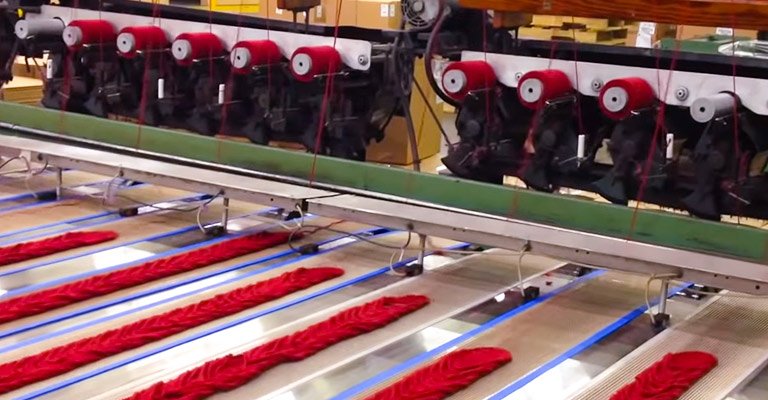The neat procedure of making yarns is based on fibers. Amongst all kinds of fibers available, the most common are cotton fibers which are collected from natural resources. Finally, the yarn we get is the product of twisted fibers and the variation is created through the spinning process.

Spuns and Filaments Yarns
Technically we define two variances that are spun yarns and filament yarns. Both yarns have their specialties even though most commons are spun yarns for knitting and fabric making. Let’s see into a deeper dive!
Spuns
Spun yarns are the base of making smooth cotton threads for either crocheting or knitting purposes. And there are also cotton threads that are interlocked for fabric weaving conditions.
When we are talking about knitting purpose yarns, we see there are multiple fibers connected. Verily the fiber quality (length) matters what output thread it will form. If you are given fibers that are short in size, then the after-twists result might turn to hairy threads, which we often see in wools.
Shortened length of fiber can be lined up by two or more, but a single fiber also works. There are these twist segments for creating threads, Z and S twists. The two or multiple strands for S twists are up-left shifted and for Z it is up-right shifted. Mono strands’ initial twist is similar to the end twist.
In the case of continuous and running fiber, we get the most top-notch strains, and mostly these are made by an industrial spinning process which is a formal machinery twist. The smooth fabrics we buy for making cloth wear are the final product of these continuous fibers.
They are large in length and the spin that’s why dealt with fine tension. While the short fibers are comparatively hard to be twisted with stretchy behavior. And the result is not too smooth.
Filaments
Filament yarns generally create fabrics that seem synthetic and glossy. And the fiber of these forms is from silk material which is collected from insects. For the mass demand, the industry has shifted to polyester threads which are technically not from natural resources. However, the end gain is satisfactory.
The silk dapper sophisticated suits and many gloss fabrics we see are the final visuals of filament yarns. And the demands are on the rise. You might know thoroughly a bit from the following site.
How to Make Yarn From Cotton?
Making yarns from direct cotton can be easier and also can be a tough thing if you haven’t tried it before. The base starts from collecting raw pieces of cotton from natural sources. Later the process for strand making initiates.
The cotton is supposed to be handled with proper tension. You can either do it with a spindle kind of tool or a spinning wheel. A spinning wheel does the work in a professional way and without any gaps.
If you do it with a spindle tool, there is a chance of discontinuous cotton. So, I need to be extra cautious. The “park and draft” method is for customizing your kind. After securing the proper strands, you are to twist them finely.
And voila you’re with your perfect yarn. Make sure you’ve locked the twist and rolled it in a pattern. There’s a demonstration of how park and draft work.
How to Make Yarns From Fiber
The building block for yarns is fiber and both natural and synthetics are choice-worthy up to usage. If we talk about staple fibers of cotton, they will be shorter in length. Whereas the synthetics can be of great length.
Fiber’s quality, length, the texture gives output as to how perfect the fabric can be. Natural resources that we collect fibers from are generally limited in size and after a certain range, we don’t get large lengths. Still, these fibers have great textures and so it’s still a tough competitor.
When we switch to filament fibers the texture is expected to be average to high-end. And the fiber length is at a satisfactory level and consequently, that gives some wonderful fabric as result.
Is Chunky and Bulky Yarn the Same?
No chunky and bulky aren’t the same yarn category. Bulky yarns are the heaviest and oversized yarn possible while chunky is leveled one position below the bulks.
The crochet gauge of 4 inches for a bulky one takes 5-6 stitches in a needle sized 11 or larger (U.S measurements). For a metric measure, the needle size will be 8mm and larger.
For chunky yarns, a crochet gauge of 4 inches will require 8-11 inches. Needle size in the U.S. measure is 9-11 (5.5-8 mm in metric). Read how to make a blanket with chunky yarn.
Yarn Made From Synthetic Fiber
Industrial demands weren’t sufficient with the supply of natural resources and also, and they required fibers that can act promptly. So, the ideology of filament fibers started.
The elements are polyesters, polyamides, acrylics, vinyl, etc. are elastomeric fibers. And for regenerated fibers, the preferable raw materials are rayon, cellulose acetates, rubber fibers, glass, and regenerated proteins.
It is hard to identify the material of synthetic fabric as the composition varies a lot. Still the diversified fabrics that synthetic fibers have introduced to the market it’s appreciable and we get to style with more these days.
Can I Make Yarns from Regular Cotton Balls?
Yes, you can. You’ll have to follow the process with spindles, where you need to loop the process till you get your number of yarns.
Conclusion
The primitive way of making yarn is time-consuming and lately, the natural resources of cotton and fibers are transformed from machinery. So sometimes we don’t only get pure spun yarns and pure synthetics but also the mixture is pretty popular. Yarns and their way of revolving lifestyle is something hard to beat.
Leave a Reply